#prehistoric wildlife
Text
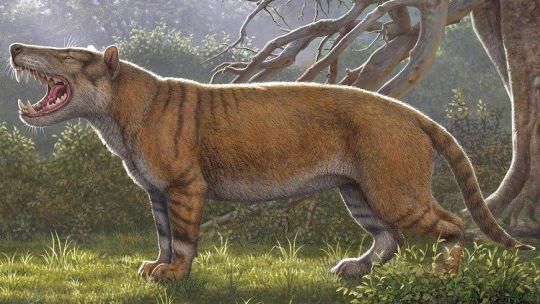
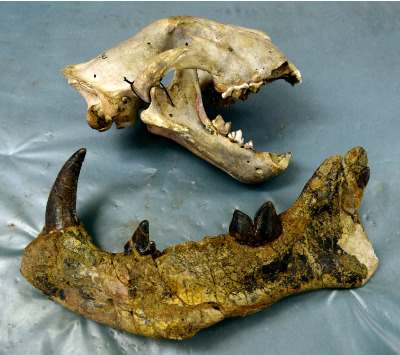
October's Fossil of the Month - Simbakubwa (Simbakubwa kutokaafrika)
Family: Hyena Cat Family (Hyainailouridae)
Time Period: 23-22 Million Years Ago (Early Neogene)
Currently known only from fossilised teeth and lower jaws discovered in Kenya's Messa Bridge fossil site, Simbakubwa kutokaaffrika was originally described as a prehistoric species of hyena before reexamination of fossils housed at the Nairobi National Museum of Kenya led to it being reclassified as a hyaenadont (a member of the extinct order Hyaenadonta, the members of which were generally dog-like animals with similar jaws and teeth to modern hyenas, although their teeth differed from true carnivorans today in that they lacked modified molars used for crushing and tearing seen in animals such as bears and dogs, and seemed to grow their teeth in slower than most modern carnivores.) While the limited variety of Simbakubwa fossils means that much of its biology is a mystery, it is notable among the hyaenadonts because of its size; estimates of its body size based on the size of its jaws suggest that, while most hyaenodonts were comparable to a large dog in size, it was at least as large as a lion, with the most generous estimates suggesting that it may have weighed as much as 1,500kg/3,307lbs (surpassing even modern Polar Bears in size,) although as the more complete fossils of related species suggest that members of the "hyena-cat" family of hyaenodonts that Simbakubwa belonged to had extremely large heads compared to their bodies it is unlikely that it actually reached such as size. Based on the shape of its teeth and the presumed strength of its jaws it is likely that Simbakubwa was purely carnivorous and fed on large mammals such as rhinoceros and gomphotheres (extinct relatives of modern elephants,) although based on the lack of any preserved teeth showing adaptations for crushing it is unclear if members of this species also fed on bones as other hyaenodonts and modern hyenas are known to do. While the circumstances of Simbakubwa's extinction are unclear, it is plausible that as the earth gradually became cooler and drier as it approached a series of "ice ages" in the later neogene resources became scarcer and large carnivores were among the first species to be affected by this. While the binomial names of most species are derived from Greek and/or Latin, Simbakubwa kutokaaffrika is Swahili, translating roughly to "great lion from Africa."
--------------------------------------------------------------------------
*Note - The second image above shows a Simbakubwa lower jaw (bottom) compared to a modern Lion skull (top.)
Image Sources: https://commons.wikimedia.org/wiki/File:Simbakubwa-kutokaafrika_2.jpg
and
https://www.nationalgeographic.com/science/article/new-species-ancient-carnivore-was-bigger-than-polar-bear-hyaenodonts
#Simbakubwa#hyeanodont#hyaenodonts#zoology#biology#paleontology#mammalogy#prehistoric wildlife#animal#animals#wildlife#African wildlife#African fossils#fossil#fossils#mammal#mammals#prehistoric animals#prehistoric mammals
245 notes
·
View notes
Text
idk why but the evolution of the whales from aquatic primitive lifeforms to land dwelling creatures then back to water to become one of largest animal in the ocean rlly gets me. i love you basilosaurus
9 notes
·
View notes
Photo
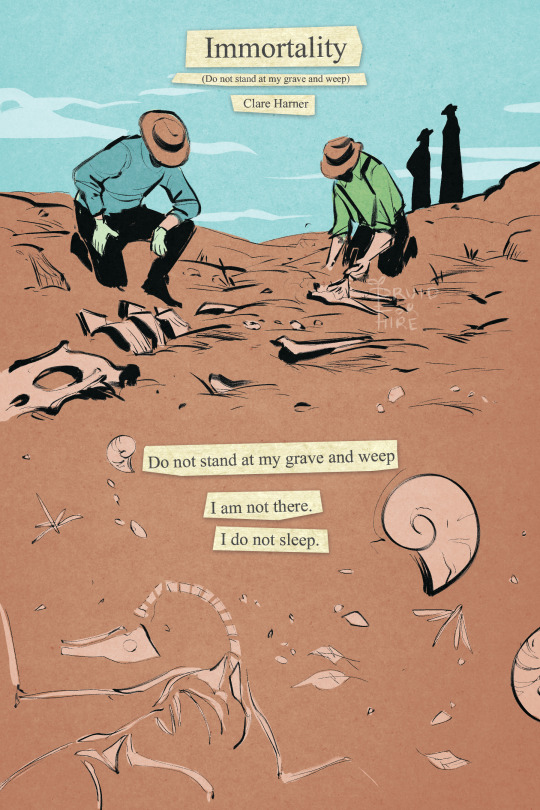

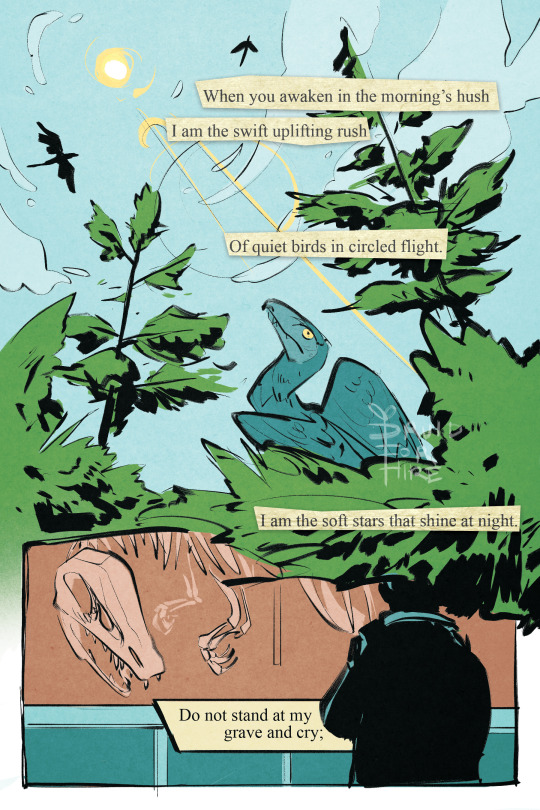
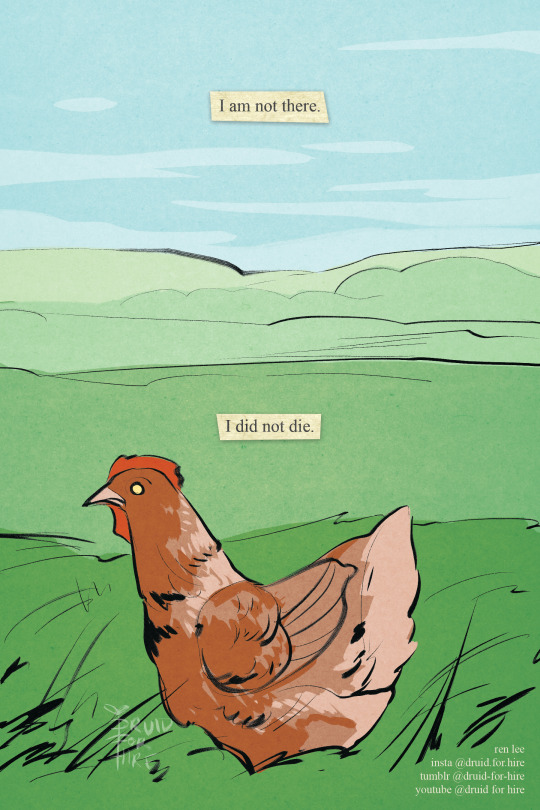
[image id: a four-page comic. it is titled "immortality” after the poem by clare harner (more popularly known as “do not stand at my grave and weep”). the first page shows paleontologists digging up fossils at a dig. it reads, “do not stand at my grave and weep. i am not there. i do not sleep.” page two features several prehistoric creatures living in the wild. not featured but notable, each have modern descendants: horses, cetaceans, horsetail plants, and crocodilians. it reads, “i am a thousand winds that blow. i am the diamond glints on snow. i am the sunlight on ripened grain. i am the gentle autumn rain.” the third page shows archaeopteryx in the treetops and the skies, then a modern museum-goer reading the placard on a fossil display. it reads, “when you awaken in the morning’s hush, i am the swift uplifting rush, of quiet birds in circled flight. i am the soft stars that shine at night. do not stand at my grave and cry.” the fourth page shows a chicken in a field. it reads, “i am not there. i did not die” / end id]
a comic i made in about 15 hours for my school’s comic anthology. the theme was “evolution”
#dinosaur#evolution#comic#prehistoric#animal#wildlife#paleontology#biology#poetry#comics#original#my art#archaeopteryx has no direct living descendants i know#but i wanted something aerial and the dinosaur to bird connection is classic and well known anyway#also the chicken over any other bird is very on purpose#its the mix of truth and comedy and genuineness and the fantastic in the mundane#its me asking you to see something so wonderful in something taken so un-seriously#and to love it both ways#also the jurassic park thing#where someone saw the reconstructed gait of a dino#and said. hey hang on. i know that walk.#and pulled up footage of a chicken walking#which jumpstarted the entire study into the link between dinosaurs and birds#in the end take whatever you want from it i just thought id provide some insight#i always like it when other artists do#the point is that i enjoy when people laugh at the end and when they dont#and i like it when they cry. i like it best when they both laugh and cry. eeaao intent#anyway mourn your losses but to live is to change#also hi guys i finally figured out tipping after 5 months so no more annoying ko-fi link
146K notes
·
View notes
Text
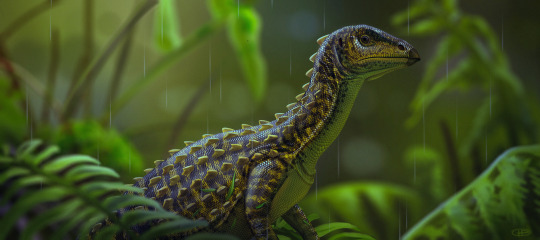
A lone scutellosaurus forages for food on the forest floor as a light rain begins to fall.
#my art#dinosaur#scutellosaurus#prehistoric#forest#ferns#rains#scales#scutes#paleontology#paleoart#paleoillustration#illustration#jurassic#small#herbivore#wildlife art#wildlife#cute
2K notes
·
View notes
Text
So the Tully Monster (Tullimonstrum gregarium) is an incredibly enigmatic extinct animal whose fossils have only been found in one section of the Mazon Creek Fossil Beds near Morris, Illinois. Dating back to around 309 million years ago during the Pennsylvanian Epoch of the Carboniferous Period, the ironstone concretions found here are particularly rich with fossils.
The Tully Monster has stymied paleontologists for decades, because no one's been entirely sure how to classify it. It doesn't resemble anything else that's been found there or elsewhere, and it didn't have any features that easily distinguished it as a vertebrate or invertebrate.
So this most recent study consisted of scientists painstakingly analyzing over 100 Tully Monster fossils, along with several dozen fossils of other species found in the same area. They were looking in particular for any traits that would suggest these were vertebrates. In short? They didn't find any. Which suggests that the Tully Monster was most likely just a very, very weird invertebrate--not so surprising given the wide diversity of aquatic invertebrates found today!
One thing the study didn't look into was the possibility that this species may have been something even more unusual--a non-vertebrate chordate. These animals have a notochord, a flexible structure that provides attachment for muscles similarly to a vertebrate's spine. While modern vertebrates may have a notochord during embryonic development, most do not retain it beyond a vestigial state once development is complete.
There will no doubt continue to be debate about just what the Tully Monster actually was, but this study adds a significant piece to the puzzle.
#fossils#paleontology#paleozoology#extinct animals#extinction#prehistoric animals#prehistory#Tully Monster#wildlife#animals#nature#science#scicomm
1K notes
·
View notes
Text
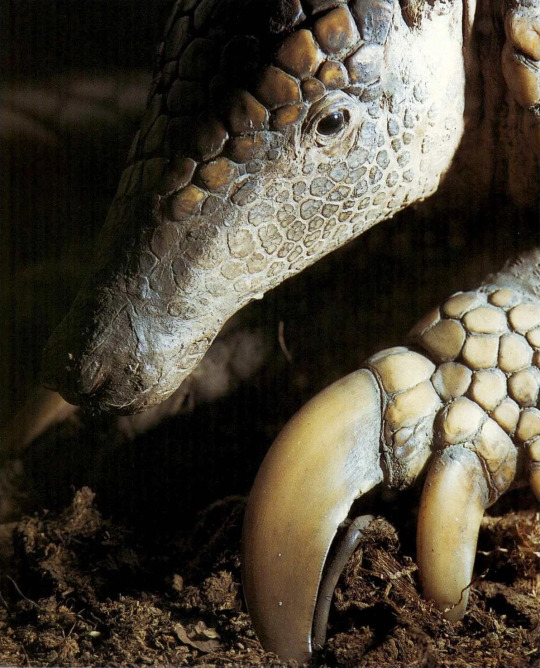
Giant armadillo
By: Unknown photographer
From: Wildlife Fact-File
1990s
#fave#this guy looks straight up prehistoric#giant armadillo#armadillo#xenarthran#mammal#1990s#Wildlife Fact-File
383 notes
·
View notes
Text

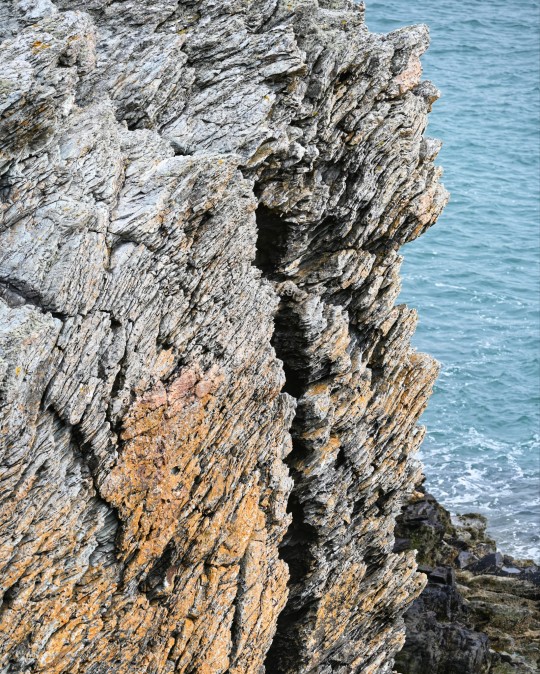
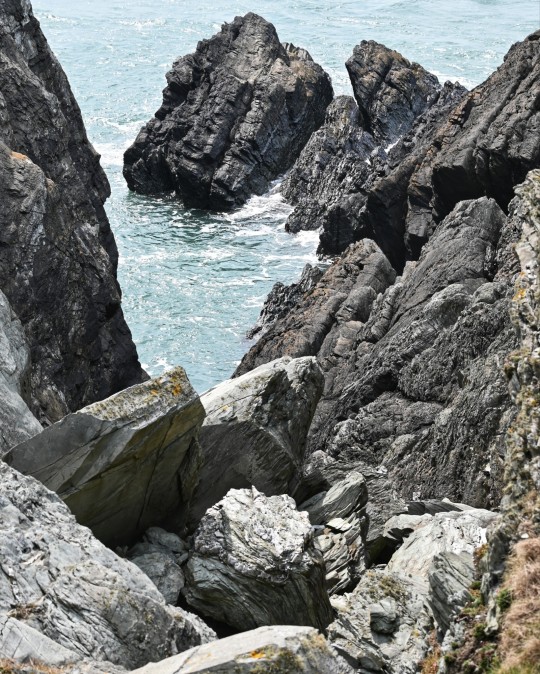
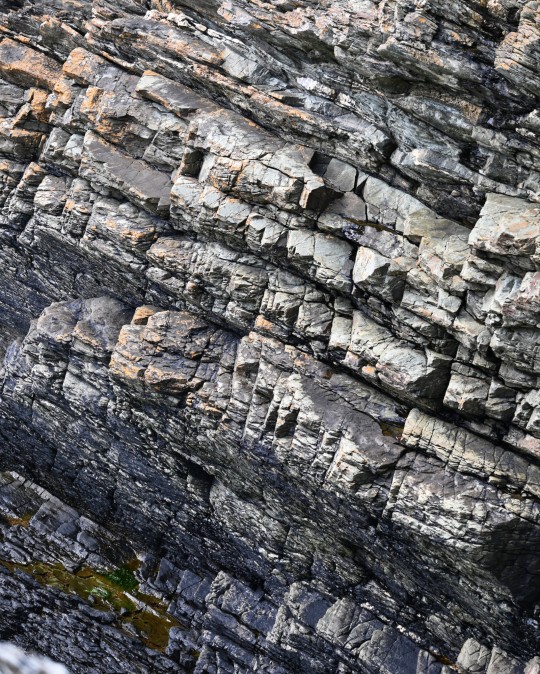
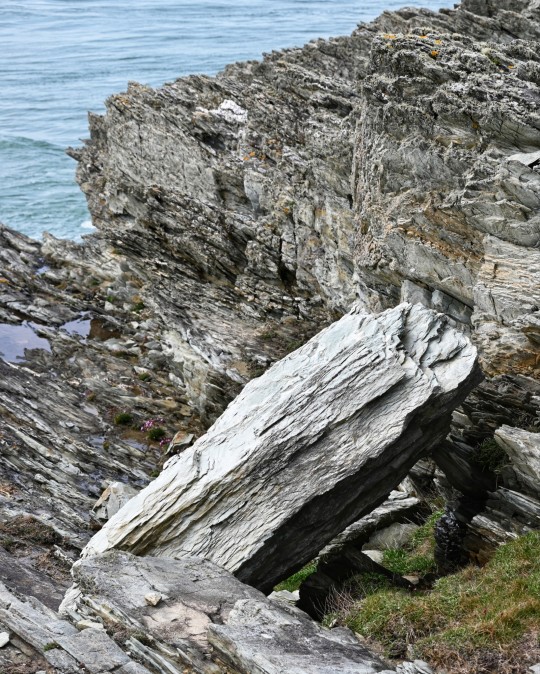
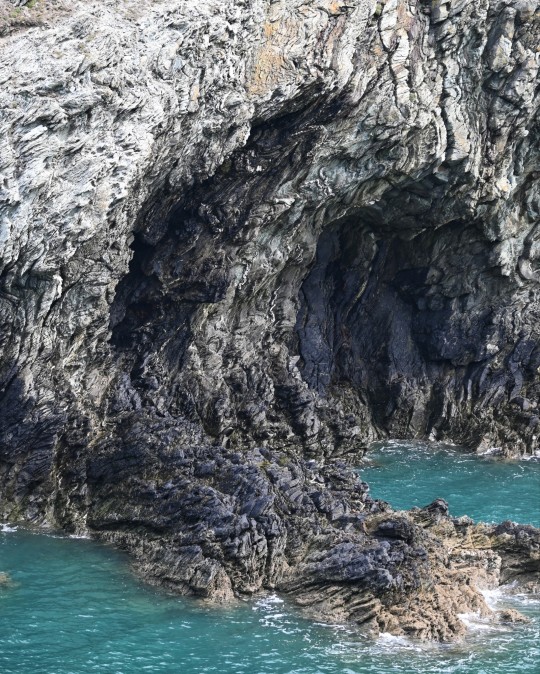
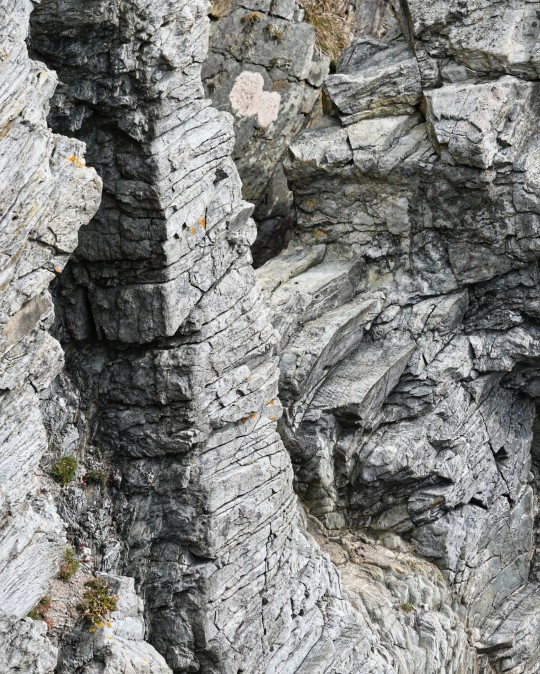
'The Range' Coastal Headlands and Iron Age Promontory Fort, Holy Island, Anglesey, Wales
#coastline#promontory fort#iron age#coastal#landscape#rockscape#wales#prehistoric#prehistory#archaeology#geology#wildlife#outdoors#walking#tribal#wild places#ancient sites#ancient living#Anglesey
159 notes
·
View notes
Text
Currently integrating #UE5 into my workflow to hopefully bring out some bigger and better projects!
#paleoart#paleoartist#animals#fossils#extinct#sciart#paleontology#iceage#3dart#blender#art#wildlife#biology#zoology#prehistoric#unrealengine#unrealengine5
102 notes
·
View notes
Text

Hey, look, there's a little thorny guy looking for food at the mouth of the cave! welcome to my first dioramas illustration. Here I painted two Scutellosaurus lawleri looking for food.
Scutellosaurus lived in the early Jurassic period. Scutellosaurus was a small plant eater of the Thyreophora group, including the stegosaurus and ankylosaurus. It is one of the earliest representatives of armored dinosaurs. Their size is also small, only about 1.5 to 2m long and weighing about 3kg
.
.
My other social media
DeviantArt: Prehistozoo
#scutellosaurus#thyreophorans#dinosaur#reptiles#herbivore#digital art#paleoart#illustration#prehistoric#wildlife#science#tumblr#diorama
31 notes
·
View notes
Text
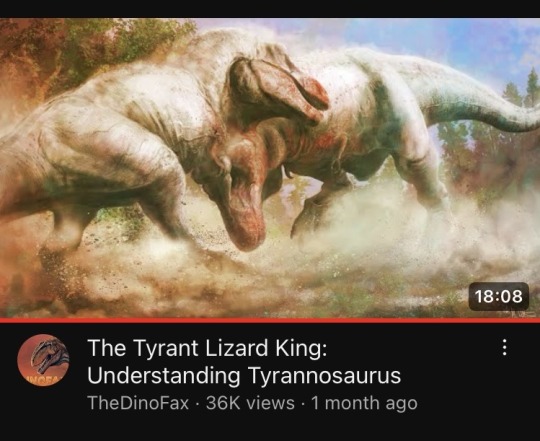
youtube
#dinofax#tyrannosaurus rex#trex#t rex#dinosaur#dinosaurs#science#science tumblr#science side of tumblr#paleontology#paleoblr#animal video#animal#prehistoric#animals#educational#educational videos#educational content#video essay#wildlife#wild animals#tumblr recommendations#recommend#recommendation#youtube recommendations#video recommendation#youtube#youtube content#youtube link#video link
16 notes
·
View notes
Text


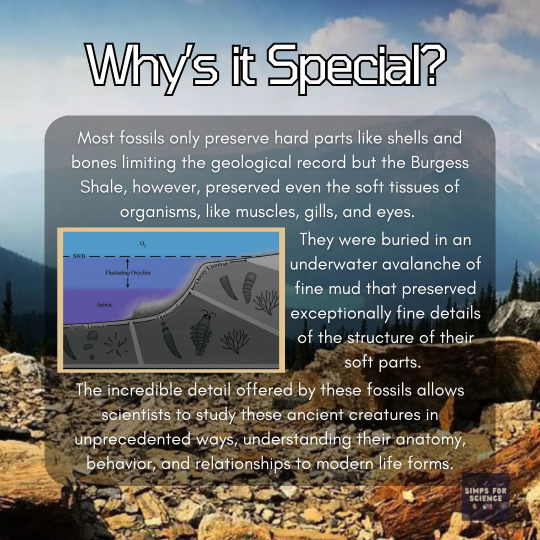
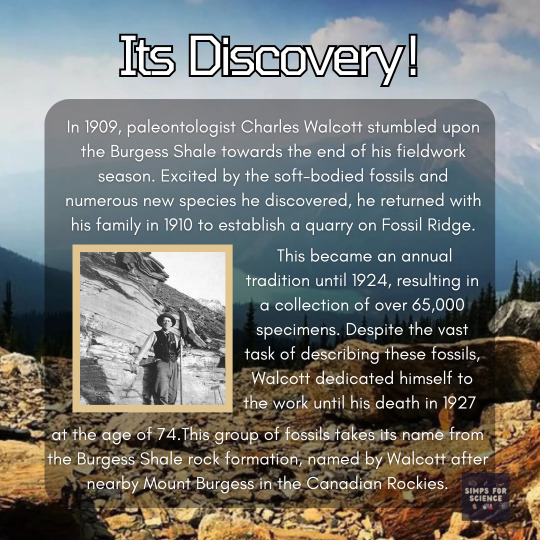

Have you ever heard of the 'Burgess Shale'? 😯 It's a goldmine of Cambrian fossils , a wonderland that is home to the most exceptional fossils from this era. Swipe through this post ➡️ to unearth the mysteries and ancient wonders that the Shale captured in its stones🪨 . To witness more of the prehistoric dance of animal life 🦕, join us on this monthly series 'Zoofabulous Time Trek'.
📸Image credits:
Image 1 - Olivia Little/ Freshdaily
Image 2- The Smithsonian National Museum of Natural History’s Burgess Shale Fossil Specimens
Image 3 - James St. John/ Wikimedia Commons
Image 4 - R. Gaines/ Semantic Scholar
Image 5 - The Burgess Shale Geoscience Foundation
#burgess shale#cambrian#cambrian explosion#fossils#paleo#paleontology#geology#zoology#animal#wildlife#fauna#prehistoric#education#science#science facts#study blog#discover#scicomm#research scientist#explore#earth
25 notes
·
View notes
Text
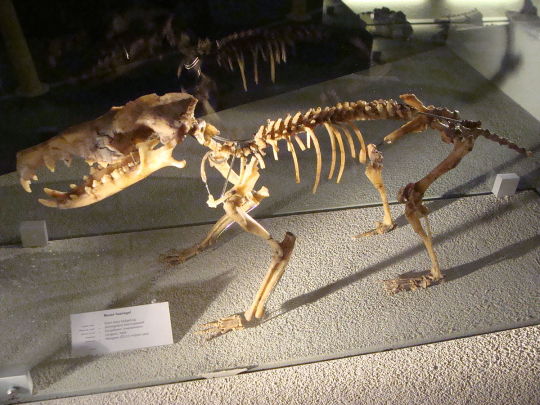

November's Fossil of the Month: Deinogalerix (Deinogalerix spp.)
Family: Hedgehog Family (Erinaceidae)
Time Period: 10-5 Million Years Ago (Late Miocene)
Native to what is now the Gargano region of southeastern Italy (which, as a result of higher sea levels, was an isolated island at the time,) the members of the genus Deinogalerix were relatives of modern hedgehogs comparable in size to small dogs. Lacking defensive spines but possessing long legs and proportionally enormous jaws, it is believed that, in the absence of large carnivores on their home island, the ancestors of this genus' members developed into fast-moving carnivores that may have fed on smaller vertebrates in addition to the invertebrates that make up the bulk of their smaller relatives' diets. The evolutionary phenomenon by which small carnivores isolated on islands gradually become larger, known as insular gigantism, is fairly well documented (being seen in both modern animals such as the Komodo Dragon and numerous extinct species known from fossils found on islands or in areas that were once islands, including a species of eagle-owl sized barn owl, Tyto gigantea, which coexisted with Deinogalerix on what is now Gargano) and is thought to occur in response to a lack of established large predators compared to nearby mainlands. The assumption that Deinogalerix species developed to exploit a lack of competition from similarly-sized predators would also explain their eventual extinction; the Miocene period ended in a major ice age, and as an increase in ocean freezing caused sea levels to fall the island on which Deionogalerix developed would have become more easily accessible from the mainland, possibly allowing for other similarly-sized or larger predators to colonise the former island and outcompete its unique inhabitants - a theory supported by the fact that Tyto gigantea also seems to have gone extinct around this time.
--------------------------------------------------------------------------
Image Sources: https://commons.wikimedia.org/wiki/File:Deinogalerix_koenigswaldi-Naturalis-PeterMaas.JPG
and
https://www.sci.news/paleontology/science-deinogalerix-masinii-new-giant-fossil-hedgehog-italy-01535.html
#Deinogalerix#deinogalerix#hedgehog#hedgehogs#biology#zoology#mammalogy#paleontology#animal#animals#prehistoric animals#wildlife#prehistoric wildlife#prehistoric mammal#prehistoric mammals#fossil#fossils#nature#European wildlife#Italian wildlife
166 notes
·
View notes
Photo
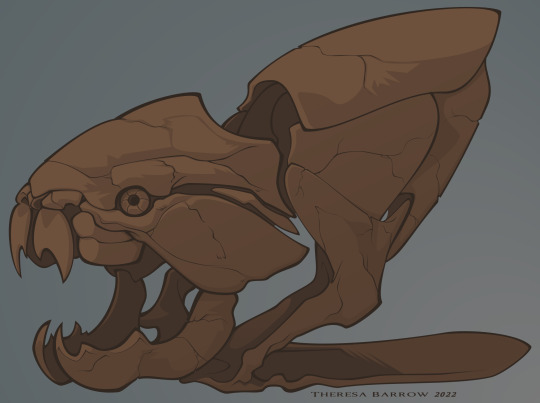
I've started doing some studies of prehistoric animals that have captured my imagination since I was a child.
Dunkleosteus is probably one of my favourites from the Devonian era.
Available on my Red Bubble store
#my art#vector art#dunkleosteus#devonian#prehistoric#fish#prehistoric fish#wildlife drawing#Paleoartistry#artists on tumblr
284 notes
·
View notes
Text

Gabhann Dunne
Archaeopteryx and wolf
#gabhann dunne#wolves#wolf#wolf art#wolf painting#archaeopteryx#animals in art#prehistoric animals#prehistoric#wildlife#wildlife art#wildlife painting#irish artist#irish painter#contemporary art#contemporary painting#contemporary artist#art history#aesthetictumblr#tumblraesthetic#tumblrpic#tumblrpictures#tumblr art#wildlife artist#beautiful animals
8 notes
·
View notes
Text
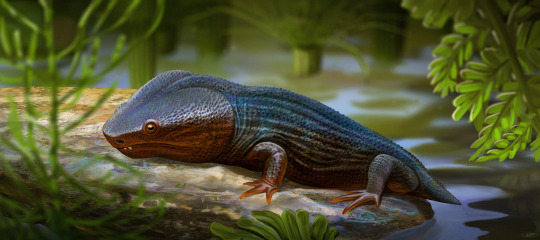
A male pantylus basks on the edge of his mating pool hoping to attract a female.
#my art#illustration#amphibian#microsaur#pantylus#paleontology#paleoart#paleoillustration#prehistoric#permian#pond#bumps#slimy#not#a#dinosaur#wildlife#wildlife art#smol
670 notes
·
View notes
Text
More for #NationalAardvarkWeek:
#DYK aardvarks are endemic to sub-Saharan Africa? They've been found in rock art from a number of sites across their native range.

Aardvark petroglyph on display at the National Museum of Cultural History in Pretoria, South Africa.
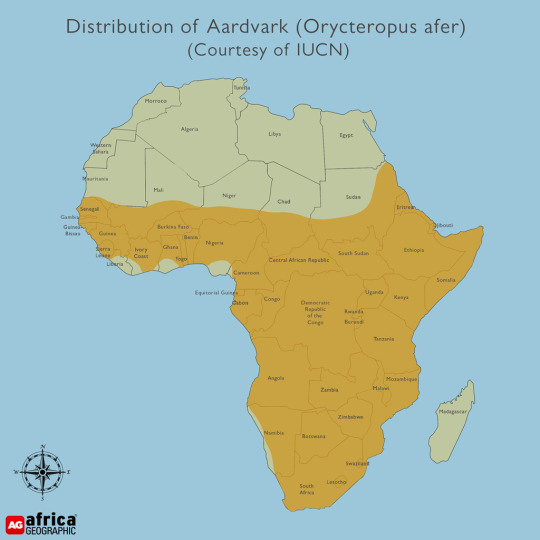
#AardvarksAareAawesome
#aardvark#rock art#petroglyph#prehistoric art#African art#African animals#African wildlife#South African art#National Museum of Cultural History Pretoria#National Aardvark Week#Aardvarks Aare Aawesome#Africa map#animals in art
30 notes
·
View notes